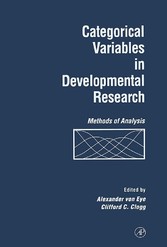Suchen und Finden
Front Cover
1
Categorical Variables in Developmental Research: Methods of Analysis
4
Copyright Page
5
Contents
6
Contributors
12
Preface
14
Acknowledgments
18
In Memoriam
20
Part 1: Measurement and Repeated Observations of Categorical Data
22
Chapter 1. Measurement Criteria for Choosing among Models with Graded Responses
24
1. Introduction
24
2. Measurement Criteria for a Model for Graded Responses
25
3. Models for Graded Responses
30
4. Examples
49
5. Summary and Discussion
53
References
55
Chapter 2. Growth Modeling with Binary Responses
58
1. Introduction
58
2. Conventional Modeling and Estimation with Binary Longitudinal Data
60
3. More General Binary Growth Modeling
63
4. Analyses
67
5. Conclusions
73
References
73
Chapter 3. Probit Models for the Analysis of Limited Dependent Panel Data
76
1. Introduction
76
2. Model Specification
77
3. Estimation Method
82
4. Analysis of Production Output from German Business Test Data
89
5. Conclusion
93
References
94
Part 2: Catastrophe Theory
96
Chapter 4. Catastrophe Analysis of Discontinuous Development
98
1. Introduction
98
2. Catastrophe Theory
100
3. Issues in Conservation
101
4. The Cusp Model
105
5. Empirical Studies
110
6. Discussion
122
References
125
Chapter 5. Catastrophe Theory of Stage Transitions in Metrical and Discrete Stochastic Systems
128
1. Introduction
128
2. Elementary Catastrophe Theory
132
3. Catastrophe Theory for Metrical Stochastic Systems
136
4. Catastrophe Theory for Discrete Stochastic Systems
146
5. General Discussion and Conclusion 128 References
149
Part 3: Latent Class and Log-Linear Models
152
Chapter 6. Some Practical Issues Related to the Estimation of Latent Class and Latent Transition Parameters
154
1. Introduction
154
2. Methods
157
3. Discussion
165
References
167
Chapter 7. Contingency Tables and Between- Subject Variability
168
1. Introduction
168
2. Association Variability
169
3. The Simulation Procedure
171
4. Tests Based on Multinomial Variability
173
5. Tests Based on Between-Subject Variability
177
6. Procedures with Two Types of Variability
182
7. Discussion
184
References
188
Chapter 8. Assessing Reliability of Categorical Measurements Using Latent Class Models
190
1. Introduction
190
2. The Latent Class Model: A Nonparametric Method of Assessing Reliability
192
3. Reliability of Dichotomous Measurements in a Prototypical Case
195
4. Assessment of Reliability by Group or by Time
199
5. Conclusion
202
References
203
Chapter 9. Partitioning Chi-Square: Something Old, Something New, Something Borrowed, but Nothing BLUE (Just ML)
204
1. Introduction
204
2. Partitioning Independence Models
205
3. Analyzing Change and Stability
211
4. How to Partition Chi-Square
216
5. Discussion
220
References
222
Chapter 10. Nonstandard Log-Linear Models for Measuring Change in Categorical Variables
224
1. Introduction
224
2. Bowker's Test
225
3. Log-Linear Models for Axial Symmetry
226
4. Axial Symmetry in Terms of a Nonstandard Log-Linear Model
227
5. Group Comparisons
230
6. Quasi-Symmetry
231
7. Discussion
234
References
235
Chapter 11. Application of the Multigraph Representation of Hierarchical Log-Linear Models
236
1, Introduction
236
2. Notation and Review
237
3. The Generator Multigraph
238
4. Maximum Likelihood Estimation and Fundamental Conditional Independencies
240
5. Examples
243
6. Summary
249
References
250
Part 4: Applications
252
Chapter 12. Correlation and Categorization under a Matching Hypothesis
254
1. Introduction
254
2. An Interesting Plot
255
3. The Binomial Effect Size Display
257
4. An Organizing Principle for Interval-Level Variables
258
5. Definition of the Matching Hypothesis
258
6. A Data Example
259
7. Correlation as a Count of Matches
262
8. Correlation as a Count of How Many Fall within a Set Range
264
9. Data Simulation
265
10. Building Uncertainties from Rounding Error into the Interpretation of a Correlation
267
11. Discussion
268
References
269
Chapter 13. Residualized Categorical Phenotypes and Behavioral Genetic Modeling
270
1. The Problem
270
2. Weighted Least-Squares Estimation
271
3. Proportional Effects Genotype–Environment Correlation Model
274
4. Method
277
5. Results
279
6. Conclusions
292
References
294
Index
296
Alle Preise verstehen sich inklusive der gesetzlichen MwSt.









